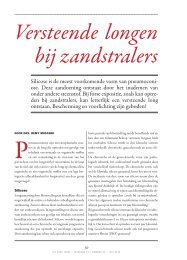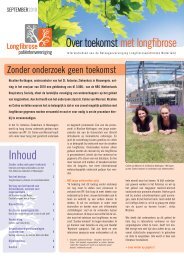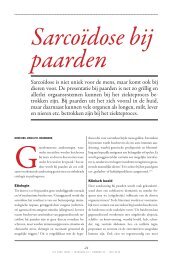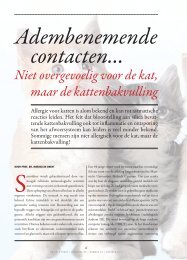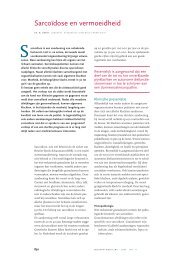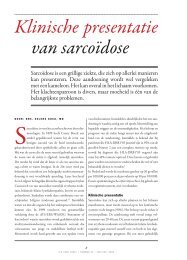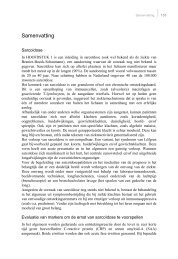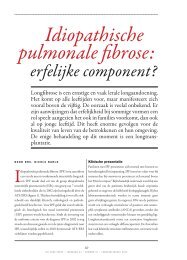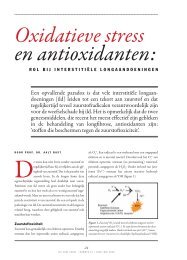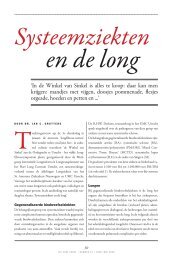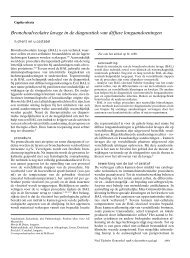Interpretation of bronchoalveolar lavage fluid cytology - ILD care
Interpretation of bronchoalveolar lavage fluid cytology - ILD care
Interpretation of bronchoalveolar lavage fluid cytology - ILD care
You also want an ePaper? Increase the reach of your titles
YUMPU automatically turns print PDFs into web optimized ePapers that Google loves.
<strong>Interpretation</strong> <strong>of</strong> BALF <strong>cytology</strong><br />
a history <strong>of</strong> exposure <strong>of</strong> respirable antigens, such as mammalian and avian proteins, the use <strong>of</strong> certain drugs [30-34],<br />
and by altered environmental factors. The presence <strong>of</strong> plasma cells together with “foamy macrophages” and an<br />
increase <strong>of</strong> the number <strong>of</strong> lymphocytes in BALF is very suggestive <strong>of</strong> the diagnosis extrinsic allergic alveolitis or<br />
drug-induced hypersensitivity pneumonitis [35-39]. In patient 2 (table 4) the total cell count was increased,<br />
predominantly the lymphocytes, but also the PMNs and eosinophils were found to be high. Furthermore, some<br />
plasma cells were found. This BALF pr<strong>of</strong>ile, together with the knowledge that the patient kept parrots, and a<br />
reticulonodular pattern demonstrated on a HRCT scan made the diagnosis extrinsic allergic alveolitis, highly likely<br />
[14, 35]. Moreover, after avoidance <strong>of</strong> exposure to the parrots the patient’s clinical condition improved and a control<br />
HRCT scan showed none <strong>of</strong> the earlier reported abnormalities anymore. In patient three a rather similar pr<strong>of</strong>ile was<br />
found. This patient was know to have rheumatoid arthritis and had recently been treated with gold injections.<br />
Thereafter, she developed a drug-induced pneumonitis induced by gold [39]. After the treatment with gold was<br />
discontinued and a short period (two weeks) <strong>of</strong> corticosteroid treatment was carried out, the clinical condition as well<br />
as functional and radiographic features <strong>of</strong> this patient improved dramatically. Other diseases with presence <strong>of</strong><br />
plasma cells in BALF include bronchiolitis obliterans with organizing pneumonia (BOOP), chronic eosinophilic<br />
pneumonia (CEP), Legionella pneumonia and malignant non-Hodgkin’s lymphoma [35, 37].<br />
Table 4. - Summary <strong>of</strong> BALF characteristics <strong>of</strong> some patients suffering from various diffuse interstitial lung diseases.<br />
Patient<br />
1 2 3 4 5 6<br />
Age, yrs 30 45 48 51 30 58<br />
Sex male female female male female male<br />
Smoking no no no no no no<br />
Yield, mL 128 75 120 80 50 75<br />
TCC x 10 4 .mL -1<br />
29 110 100 20 64 22<br />
Alveolar macrophages, % 65.8 18.2 19.6 65.7 43.2 6.1<br />
Lymphocytes, % 33.2 61.6 51.0 14.8 43.2 19.9<br />
PMNs, % 0.6 12.8 22.2 12.4 4.2 84.0<br />
Eosinophils, % 0.2 6.2 7.0 6.8 42.8 0<br />
Mast cells, % 0.2 1.0 0.2 0.3 0.4 0<br />
Plasma cells, % 0 0.2 0 0 0 0<br />
CD4/CD8 ratio 1.2 1.8 1.9 2.8 0.8 2.2<br />
Culture negative negative negative negative negative negative<br />
Most likely diagnosis Sar EAA DP IPF AEP SwS<br />
(99.9%)* (99.6%)* (98.1%)* (94.3%)* (nd) (nd)<br />
TCC: total cell count; PMNs: polymorphonuclear neutrophils; Sar: sarcoidosis; EAA:extrinsic allergic alveolitis induced by parrots;<br />
DP: drug-induced pneumonitis induced by gold in a patient with rheumatoid arthritis; AEP: acute eosinophilic pneumonia induced<br />
by minocycline; SwS: Sweet’s syndrome with pulmonary involvement associated with myelodysplasia [46]; nd: not done; *most likely<br />
diagnosis with likelihood ratio as predicted with a computer model.<br />
Idiopathic pulmonary fibrosis<br />
Idiopathic pulmonary fibrosis or cryptogenic pulmonary fibrosis has no pathognomic clinical, biochemical or<br />
pathologic features. This entity is currently diagnosed by exclusion <strong>of</strong> other specific entities resembling idiopathic<br />
pulmonary fibrosis. In line with this, the <strong>lavage</strong> pr<strong>of</strong>ile alone is nonspecific in idiopathic pulmonary fibrosis [12, 14].<br />
However, the cellular BALF pr<strong>of</strong>ile appeared to be quite different from the BALF pr<strong>of</strong>ile assessed from patients<br />
suffering from disorders with similar clinical presentation, e.g. sarcoidosis or hypersensitivity pneumonitis (table 4,<br />
patient 4) [14]. An increase in the number <strong>of</strong> PMNs in 70-90% <strong>of</strong> the cases, together with an increase in the number<br />
<strong>of</strong> eosinophils in 40-60%, and, additionally, an increase in lymphocytes in 10-20% was reported [11, 12, 14]. An<br />
increase in lymphocytes alone is quite rare in idiopathic pulmonary fibrosis, and other diseases should then<br />
thoroughly be excluded. Although BALF <strong>cytology</strong> is nonspecific, it can be very helpful in certain clinical<br />
circumstances. For example, a patient with slowly progressive D<strong>ILD</strong>, finger clubbing, and subpleural fibrosis with<br />
honeycombing found on HRCT.<br />
Other diffuse interstitial lung diseases<br />
A pronounced increase <strong>of</strong> the number <strong>of</strong> neutrophils is also found in other lung diseases, e.g. acute respiratory<br />
distress syndrome (ARDS) [40], bacterial pneumonia [25, 41], subacute extrinsic allergic alveolitis [8, 38], collagen<br />
vascular diseases [8, 42], connective-tissue disorders [8, 43] or idiopathic bronchiolitis obliterans [43, 44] (table 3).<br />
Furthermore, myeloproliferative disorders associated with Sweet’s syndrome may involve extra cutaneous sites<br />
including the lung (table 4) [46, 47].<br />
A predominant eosinophilia is indicative <strong>of</strong> an eosinophilic pneumonia, the Churg-Strauss syndrome, allergic<br />
bronchopulmonary aspergillosis, or a drug-induced eosinophilic lung reaction (tables 3,4) [8, 11, 48]. Using<br />
monoclonal antibody techniques, pulmonary histiocytosis X can be diagnosed in the appropriate clinical setting<br />
Bronchoalveolar <strong>lavage</strong>. Drent et al. Eur Respir Mon 2000. 5



